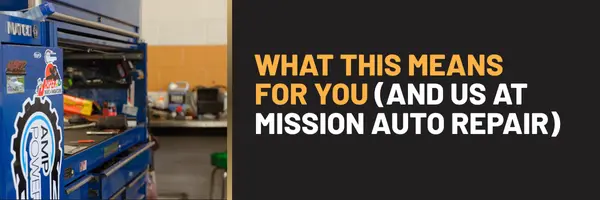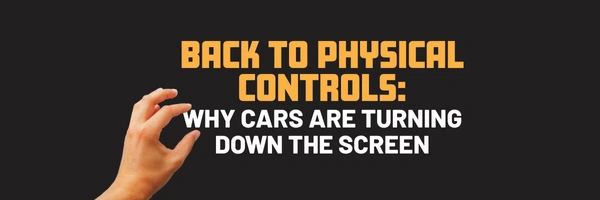Modern cars keep getting smarter. From massive touchscreens to connected apps, we’ve come to expect flashy interfaces and digital control panels in nearly every new vehicle. But lately there’s been a growing pushback. Many drivers are saying “enough”. They want simpler, safer, more tactile ways to control key functions in the car.
At Mission Auto Repair, we understand that safety often comes in the small details. Whether you’re adjusting the temperature, tapping the climate control, or turning on your windshield wipers, the tools you use matter, not just how they look. That’s why we’re paying close attention to a trend many automakers are adopting: bringing back physical buttons, knobs, and switches for essential car functions.
What’s Driving the Shift
1. Safety & Distraction Concerns
Touchscreens offer sleek design and digital features, but they also tend to demand more visual attention. According to a Wired article: physical buttons are less time-consuming to operate than touchscreens. In a test by Swedish magazine Vi Bilägare, tasks like changing cabin temperature or tuning a radio took only about 10 seconds with physical buttons in a 2005 Volvo; similar tasks took up to 45 seconds using touchscreens in more modern vehicle models.
Regulators are also beginning to take notice. Euro NCAP has announced that from 2026, to achieve five-star safety ratings, automakers will need to include physical controls for functions such as turn signals, hazard lights, and windshield wipers, rather than tuck them away in digital menus.
2. Consumer Frustration & Preference
Much of the shift is simply customer feedback. In focus groups, people report being frustrated when they have to dig through touchscreen menus just to adjust the temperature, or when basic controls are hidden in multi-layered digital interfaces. Some brands—Hyundai among them—have openly admitted they are adding back buttons and knobs for essential controls after feedback revealed that simpler, tactile controls are preferred.
A survey by What Car? magazine found that nearly 90% of drivers prefer physical buttons over touchscreens for many basic functions, citing ease of use and safety concerns.
Where Digital Still Shines
This doesn’t mean touchscreens are all bad. For navigation, media streaming, detailed settings, or fully digital instrument clusters, screens offer flexibility and modern features that can’t always be matched by physical buttons. The key is balance—to preserve what touchscreens do well, while ensuring essential, frequently used controls remain intuitive and easy to use without visual distraction.
 What This Means for You (and Us at Mission Auto Repair)
What This Means for You (and Us at Mission Auto Repair)
At Mission Auto Repair, safety and usability are central values. Here’s how this trend impacts what we do:
- Inspection focus: When we inspect a vehicle, we check not just whether your HVAC, audio, and light systems work, but whether the physical buttons, knobs, toggles are responsive, intuitive, and safe. If your driver has to take eyes off the road to use basic functions like wipers, volume, or climate control, that’s a concern we want to help correct.
- Service advice based on experience: We see many older cars with well-worn buttons that still outperform touchscreen controls when things get rough—road vibrations, glare, cold weather. Physical controls are less likely to lag, fail, or misread input under those conditions.
- Helping you make informed choices: If you’re looking to buy or upgrade, we can help you think through what matters. Does a large touchscreen matter most, or do you want tactile controls for everyday safety? We can help inspect your car now and make recommendations based on your driving needs.
Real World Examples
- Hyundai has reversed course on touchscreen dominance, restoring physical buttons and knobs for things like climate control and ventilation in newer models after feedback from users. The Verge+1
- Brands like Volkswagen are also reintroducing physical controls in their designs—volume knobs, hazard buttons, fan controls—and making them standard in coming models.

Balancing Innovation and Practicality
It’s becoming clear that not every car function needs to be controlled via a screen. For example, a driver should be able to adjust volume, turn on hazard lights, or switch on windshield wipers without navigating through a touchscreen menu. Physical buttons give feedback by feel—something digital interfaces struggle to replicate.
Meanwhile, screens still offer convenience where more complex interactions are required. For instance, full navigation, vehicle settings, or infotainment features are areas where digital interfaces shine. The ideal design is one where your vehicle has both: physical controls for essential functions, and digital tools for supplementary or non-urgent tasks.
 What You Can Do Now for a Safer Ride
What You Can Do Now for a Safer Ride
- If your car has mainly touchscreen controls, test how quickly and safely you can use them while driving (ideally, when parked or during quiet moments first). If you find yourself looking away from the road too much, that’s a sign to get controls checked or serviced.
- Ask us during your next service to evaluate your vehicle’s essential physical controls—buttons, knobs, visibility, responsiveness—and make sure nothing is confusing or malfunctioning.
- As the weather cools and roads get wetter or darker, tactile feedback becomes even more critical—gloved hands, glare, moisture all can reduce touchscreen effectiveness more than simple mechanical controls.
Mission’s Philosophy
At Mission Auto Repair, we’ve always believed that car care should be straightforward and honest. That’s why this industry trend back toward simplicity speaks to us. A reliable knob or button isn’t about being old-fashioned—it’s about making sure drivers can focus on the road, not on fumbling through menus.
For us, it’s a reminder that technology should serve safety, not the other way around. Whether it’s helping a customer understand a repair, explaining options clearly, or ensuring that every feature in your car works the way it should, we keep things simple, practical, and safe. Sometimes the safest choice really is the simplest one.
Schedule a check-up today to inspect your car’s control systems—physical knobs, buttons, switches—and make sure everything works the way you expect.
👉 Visit https://missionautorepairshop.com/ to learn more or book your inspection. Your safety and comfort behind the wheel depend on both big systems and small touches.


